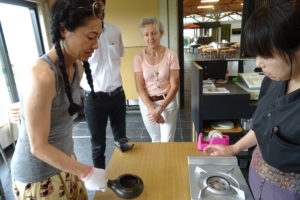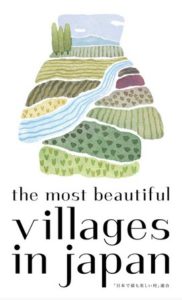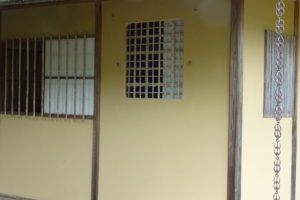
Sipping from a tea bowl of matcha I had whisked with the powder I had ground from tencha leaves, I savored the view from Hoshino Village’s Tea Culture Museum. Curving rows of green tea snugly hugged steep green slopes below. Verdant rice stalks and golden florets shimmered in tiny plots near the tea fields. Above the tea and rice, bamboo stalks bowed with the breeze. Sparkling water trickled down culverts into a rocky river.
It is an ordinary scene in Hoshino, Yame City, Japan, which grows tea that consistently wins national and international awards. A local tea farmer attributes Hoshino’s success in producing award-winning gyokuro to the soil. But I believe that the cultural milieu of Hoshino influences the quality of its teas.


For more than six hundred years, Hoshino villagers have experimented with growing, processing, and savoring tea. Each season’s tea is the culmination of generations of skills and knowledge accretion, which is what you’ll discover inside the village’s interactive tea culture museum.
Tourism and traffic are almost non-existent despite the incredible tea and natural attractions. And the picturesque drive to the mountaintop museum provides surprises.

Hoshino Village is in a remote area of Kyushu Island where the environment is so beautiful that the NPO, The Association of the Most Beautiful Villages in Japan, lists Hoshino among the top.

We encountered wild boar in the middle of the road leading to the museum. A sow didn’t budge as we approached. She defiantly marched towards us. The driver, a local tea farmer, reversed, telling us that boars occasionally charge cars. After we had retreated about 30 yards, she shot us a long stern look. Then, she strode after her piglets that had disappeared between rows of bushy tea plants. Boars sometimes dig in the soil of tea farms to find worms.
Upon arrival, we breathed fresh forest air along a tranquil stone trail under tree branches while strolling into the museum, an airy, building that merges modern and Japanese aesthetics.
Japanese tea history from ancient to contemporary is on display with an emphasis on Kyushu, including information about a historical monk named Eisai (1141-1215). He was the first to plant tea in Kyushu. There is a contemporary manga (Japanese comic book), titled Cooking Papa, featuring a Japanese gourmet visiting the museum.

Grinding matcha was fun. For 500 yen (around US$4.50), we received tencha leaves, use of a traditional stone matcha mill, and professional guidance. First, we placed the broken leaves into a hole at the top of the mill. Then we gripped a bamboo handle and rotated the mill’s top half. The tea leaves moved downward. Powdery matcha spilled out between the two main sections of the stone mill onto a bamboo tray. Using a tiny brush and pan, we collected the vibrant green powder.

We also roasted tea. First, we put fresh green tea leaves into a hoji-ki, an implement resembling a small teapot, but the hollow handle widens at the end. We placed it over a gas stove. When the hoji-ki became hot enough, our museum guide told us to shake it and to flip the tea like one flips pancakes. As the green tea turned ginger brown, a warm earthy smell enveloped us. Finally, we held the hoji-ki with the handle pointing down. The roasted tea poured out.
It felt like a great time to drink tea, so we brought our tea to a table with a view. For a small fee, museum waitstaff provided us with bamboo tea whisks and other tea utensils as well as colorful Japanese sweets known as wagashi. They are usually very sweet. Confectionary is commonly served with koicha which means thick tea. They also taught us how to whisk the matcha and when to drink.

When you go
Useful Information for Visiting the Tea Culture Museum
Address: 10816-5 Hoshino-mura, Yame-gun, Fukuoka
Hours: 10:00-17:00 (Closed on Tuesday)
Entrance Fee: Adults 500 yen / Children 300 yen
Phone: 0943-52-3003
Japanese Webpage: http://www.hoshinofurusato.com
 After savoring our teas and the views, we toured the top floor of the museum, where several tea rooms were available for tea schools and individuals to rent. Though new, the building materials were traditional bamboo, wood, and tatami.
After savoring our teas and the views, we toured the top floor of the museum, where several tea rooms were available for tea schools and individuals to rent. Though new, the building materials were traditional bamboo, wood, and tatami.
We discovered an ancient earthen building sitting adjacent to the museum. To my amazement, I realized that museum designers had created a replica of Jo-an, one of the most famous tea houses in Japan. Oda Uraku, a disciple of Sen no Rikyu, built the original Jo-an in 1618. The Japanese government later designated Jo-an as a national cultural treasure.
We could admire a traditional waiting bench. Moss and ferns grew lushly over the soil and the thatched roof of a gate. We found a beautifully carved stone lantern and a stone water-basin for purifying oneself before entering the tea ceremony house. The door was tiny and low. Samurai would have to remove their swords before entering. All tea drinkers had to stoop to go inside, which symbolized the concept that all people are equal—an excellent thought, indeed.
Tea Market
Get More Value from Your Tea: BRU Maker One
+41794574278
Jacque's Organics
(647) 804-7263



I’ve been there last spring, enjoyed driving in and out tea plantations . Loved sipping a tea at Hoshino and also tasted a very good ice cream admiring the green of the new shoots on the trees. It’s such a quite and poetic location…
Thank you, Giulia, for your comments. I absolutely agree with your description of the area as a “poetic location.” That is an apt phrase. I wish that I had thought of it.
I used to live in Kyushu. I have visited this place. The views and tea are as good as the author wrote.
Thank you for your comments. Kyushu is a wonderful island. Off the main tourist routes of Japan, not many tourists go there. But it has a lot to offer visitors.
I noticed on top of the lush green gate a plant that also grows here in the Midwest – poke weed. It is always relegated to the backside of my gardens for it can grow 6′ tall. In the fall, the fat
dark purple “blueberry like” berries grow on fuchsia dangles. The birds particularly love them! So leave and feed them as winter closes in. Enjoyed the article. paula winchester
You have great plant identification skills. I wonder if poke weed is native to both the US and Japan or if it is an invasive species.
I love tea and drink at least one large pot full daily. This article was extremely interesting. The scenery was really beautiful and made me want to see it in person.
I am glad that you enjoyed the article and the images. Your comments gave me a sense of reward. Thank you for writing.